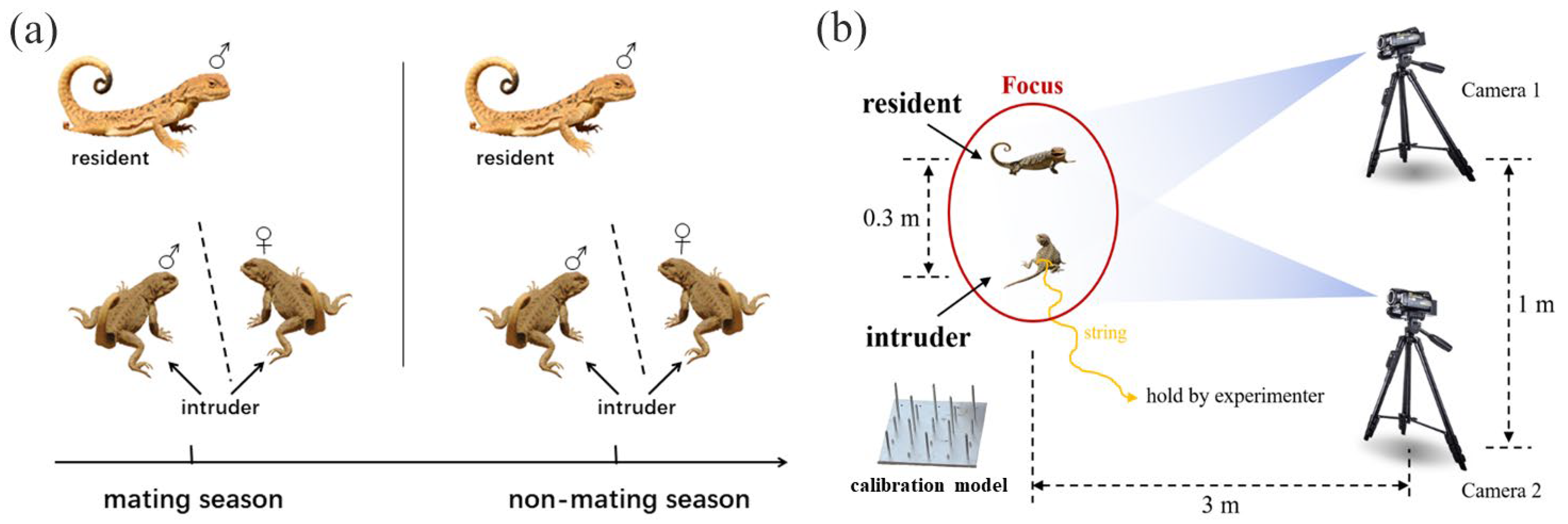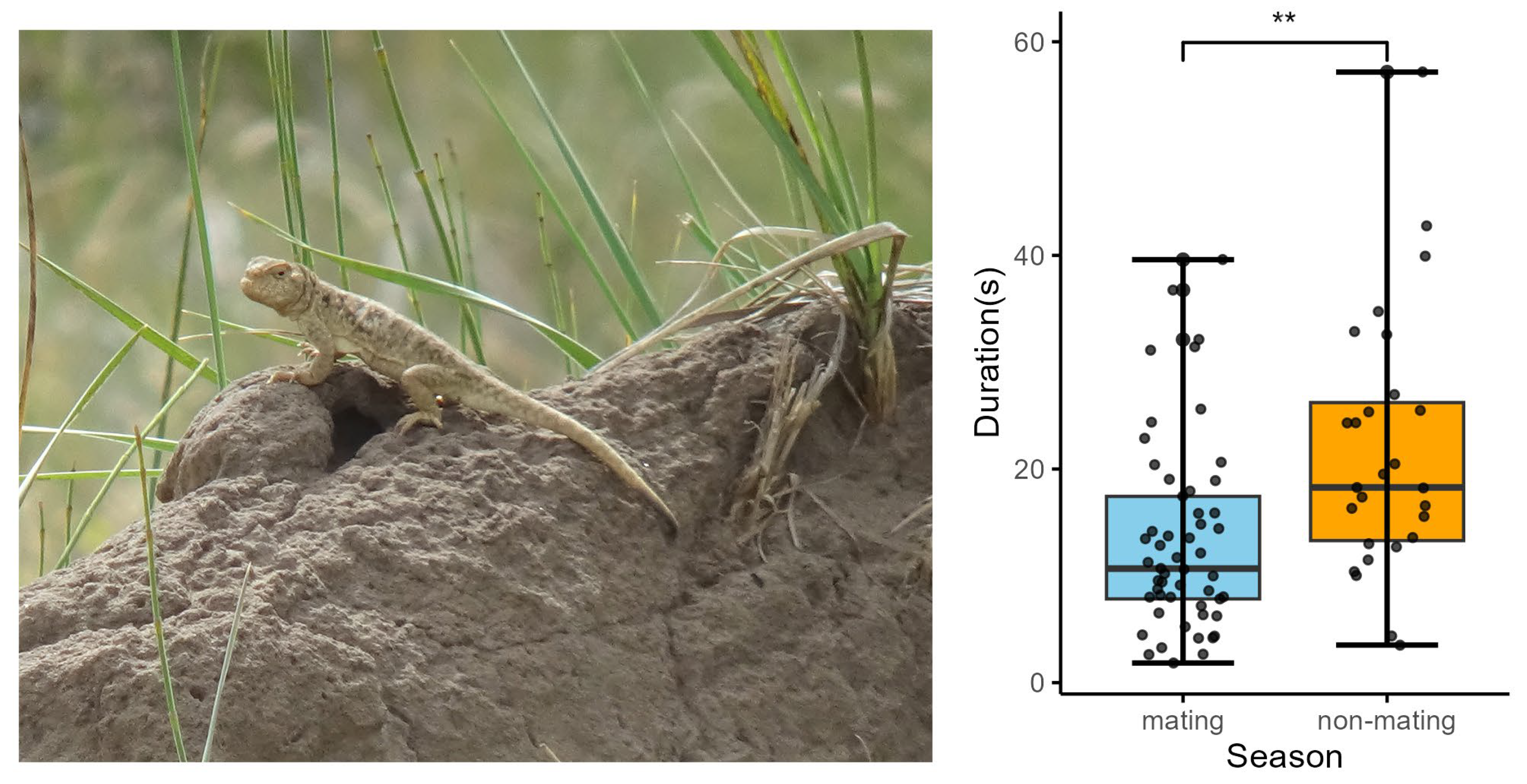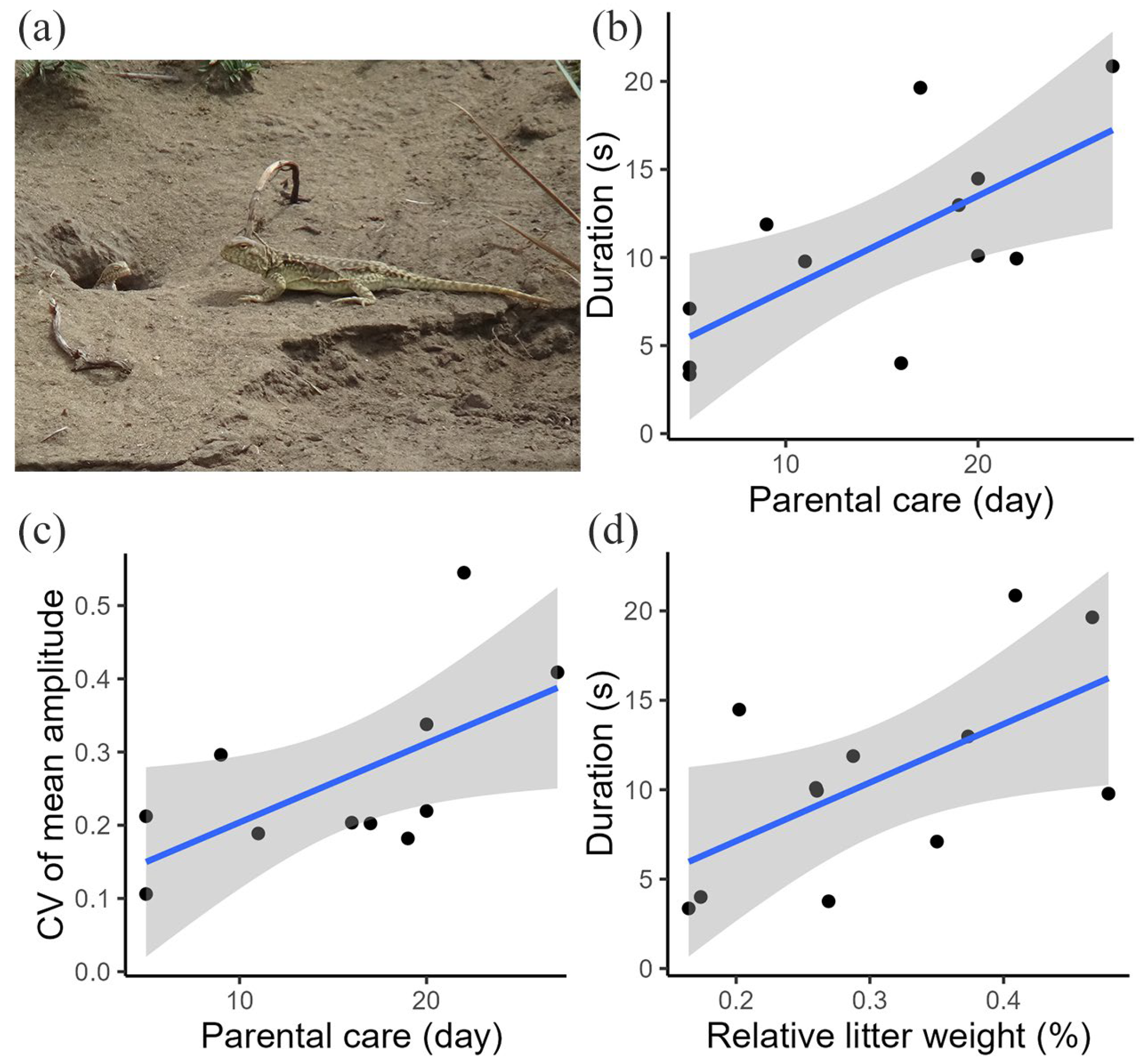Links Between Variation in Movement-Based Visual Signals and Social Communication Complexity in an Asian Agamid Lizard Phrynocephalus vlangalii
Simple Summary
Abstract
1. Introduction
2. Materials and Methods
2.1. Study Site and Species
2.2. Male Display Collection
2.3. Female Display Collection and Reproductive Investment Measurement
2.4. Display Digitization and Variation Estimation
2.5. Statistical Analysis
3. Results
3.1. Differences in Variation in Male Movement-Based Visual Signals Between Mating and Non-Mating Seasons
3.2. Relationship Between Variation in Female Movement-Based Visual Signals and Parental Care
3.3. Relationship Between Variation in Female Movement-Based Visual Signals and Energetic Investment
4. Discussion
5. Conclusions
Supplementary Materials
Author Contributions
Funding
Institutional Review Board Statement
Informed Consent Statement
Data Availability Statement
Acknowledgments
Conflicts of Interest
References
- Laidre, M.E.; Johnstone, R.A. Animal signals. Curr. Biol. 2013, 23, R829–R833. [Google Scholar] [CrossRef] [PubMed]
- Penar, W.; Magiera, A.; Klocek, C. Applications of bioacoustics in animal ecology. Ecol. Complex. 2020, 43, 100847. [Google Scholar] [CrossRef]
- Martins, E.P. Structural complexity in a lizard communication system: The Sceloporus graciosus push-up display. Copeia 1994, 1994, 944–955. [Google Scholar] [CrossRef]
- Ramos, J.A.; Peters, R.A. Habitat-dependent variation in motion signal structure between allopatric populations of lizards. Anim. Behav. 2017, 126, 69–78. [Google Scholar] [CrossRef]
- Sharma, N.; Prakash, S.V.; Kohshima, S.; Sukumar, R. Asian elephants modulate their vocalizations when disturbed. Anim. Behav. 2020, 160, 99–111. [Google Scholar] [CrossRef]
- Brumm, H.; Slabbekoorn, H. Acoustic communication in noise. Adv. Study Behav. 2005, 35, 151–209. [Google Scholar]
- Wiley, R.H. Noise Matters: The Evolution of Communication; Harvard University Press: Cambridge, MA, USA, 2015; p. xi + 502. ISBN 9780674744127. [Google Scholar]
- Calabrese, G.M.; Pfennig, K.S. Climate change alters sexual signaling in a desert-adapted frog. Am. Nat. 2023, 201, 91–105. [Google Scholar] [CrossRef]
- Vicente, N.S.; Halloy, M. Chemical recognition of conspecifics in a neotropical lizard, Liolaemus pacha (Iguania: Liolaemidae): Relation to visual displays, season and sex. J. Ethol. 2016, 34, 329–335. [Google Scholar] [CrossRef]
- Ord, T.J.; Charles, G.K.; Hofer, R.K. The evolution of alternative adaptive strategies for effective communication in noisy environments. Am. Nat. 2011, 177, 54–64. [Google Scholar] [CrossRef][Green Version]
- Prieur, J.; Barbu, S.; Blois-Heulin, C.; Lemasson, A. The origins of gestures and language: History, current advances and proposed theories. Biol. Rev. 2020, 95, 531–554. [Google Scholar] [CrossRef]
- Freeberg, T.M.; Ord, T.J.; Dunbar, R.I.M. The social network and communicative complexity: Preface to theme issue. Philos. Trans. R. Soc. B-Biol. Sci. 2012, 367, 1782–1784. [Google Scholar] [CrossRef] [PubMed][Green Version]
- Nettle, D. Social scale and structural complexity in human languages. Philos. Trans. R. Soc. B-Biol. Sci. 2012, 367, 1829–1836. [Google Scholar] [CrossRef] [PubMed]
- Dunbar, R.I.M. Bridging the bonding gap: The transition from primates to humans. Philos. Trans. R. Soc. B-Biol. Sci. 2012, 367, 1837–1846. [Google Scholar] [CrossRef] [PubMed]
- Pollard, K.A.; Blumstein, D.T. Evolving communicative complexity: Insights from rodents and beyond. Philos. Trans. R. Soc. B-Biol. Sci. 2012, 367, 1869–1878. [Google Scholar] [CrossRef]
- Freeberg, T.M.; Dunbar, R.I.M.; Ord, T.J. Social complexity as a proximate and ultimate factor in communicative complexity. Philos. Trans. R. Soc. B-Biol. Sci. 2012, 367, 1785–1801. [Google Scholar] [CrossRef]
- Fichtel, C.; Kappeler, P.M. Coevolution of social and communicative complexity in lemurs. Philos. Trans. R. Soc. B Biol. Sci. 2022, 377, 20210297. [Google Scholar] [CrossRef]
- Krams, I.; Krama, T.; Freeberg, T.M.; Kullberg, C.; Lucas, J.R. Linking social complexity and vocal complexity: A parid perspective. Philos. Trans. R. Soc. Lond. B Biol. Sci. 2012, 367, 1879–1891. [Google Scholar] [CrossRef]
- McComb, K.; Semple, S. Coevolution of vocal communication and sociality in primates. Biol. Lett. 2005, 1, 381–385. [Google Scholar] [CrossRef]
- Ord, T.J.; Martins, E.P. Tracing the origins of signal diversity in anole lizards: Phylogenetic approaches to inferring the evolution of complex behaviour. Anim. Behav. 2006, 71, 1411–1429. [Google Scholar] [CrossRef]
- Ord, T.J.; Garcia-Porta, J. Is sociality required for the evolution of communicative complexity? Evidence weighed against alternative hypotheses in diverse taxonomic groups. Philos. Trans. R. Soc. B-Biol. Sci. 2012, 367, 1811–1828. [Google Scholar] [CrossRef]
- Rebout, N.; De Marco, A.; Lone, J.-C.; Sanna, A.; Cozzolino, R.; Micheletta, J.; Sterck, E.H.M.; Langermans, J.A.M.; Lemasson, A.; Thierry, B. Tolerant and intolerant macaques show different levels of structural complexity in their vocal communication. Proc. R. Soc. B Biol. Sci. 2020, 287, 20200439. [Google Scholar] [CrossRef] [PubMed]
- Leighton, G.M. Cooperative breeding influences the number and type of vocalizations in avian lineages. Proc. R. Soc. B Biol. Sci. 2017, 284, 20171508. [Google Scholar] [CrossRef] [PubMed]
- Papale, E.; Fanizza, C.; Buscaino, G.; Ceraulo, M.; Cipriano, G.; Crugliano, R.; Grammauta, R.; Gregorietti, M.; Renò, V.; Ricci, P.; et al. The social role of vocal complexity in striped dolphins. Front. Mar. Sci. 2020, 7, 584301. [Google Scholar] [CrossRef]
- How, M.J.; Zeil, J.; Hemmi, J.M. Differences in context and function of two distinct waving displays in the fiddler crab, Uca perplexa (Decapoda: Ocypodidae). Behav. Ecol. Sociobiol. 2007, 62, 137–148. [Google Scholar] [CrossRef]
- How, M.J.; Zeil, J.; Hemmi, J.M. Variability of a dynamic visual signal: The fiddler crab claw-waving display. J. Comp. Physiol. A-Neuroethol. Sens. Neural Behav. Physiol. 2009, 195, 55–67. [Google Scholar] [CrossRef]
- Peters, R.A.; Ramos, J.A.; Hernandez, J.; Wu, Y.; Qi, Y. Social context affects tail displays by Phrynocephalus vlangalii lizards from China. Sci. Rep. 2016, 6, 31573. [Google Scholar] [CrossRef]
- Wu, Y.; Ramos, J.A.; Qiu, X.; Peters, R.A.; Qi, Y. Female–female aggression functions in mate defence in an Asian agamid lizard. Anim. Behav. 2018, 135, 215–222. [Google Scholar] [CrossRef]
- Qiu, X.; Fu, J.; Qi, Y. Tail waving speed affects territorial response in the toad-headed agama Phrynocephalus vlangalii. Asian Herpetol. Res. 2018, 9, 182–187. [Google Scholar]
- Qiu, X.; Hu, Q.; Peters, R.; Yue, B.; Fu, J.; Qi, Y. Unraveling the content of tail displays in an Asian agamid lizard. Behav. Ecol. Sociobiol. 2021, 75, 117. [Google Scholar] [CrossRef]
- Wu, Y.; Whiting, M.J.; Fu, J.; Qi, Y. The driving forces behind female-female aggression and its fitness consequence in an Asian agamid lizard. Behav. Ecol. Sociobiol. 2019, 73, 73. [Google Scholar] [CrossRef]
- Liu, J.; Qi, Y. The Driving Role of Social Complexity in the Dynamic Visual Signals of Phrynocephalus vlangalii; Chengdu Institute of Biology, Chinese Academy of Sciences: Chengdu, China, 2024; manuscript in preparation. [Google Scholar]
- Wu, Y.; Fu, J.; Yue, B.; Qi, Y. An atypical reproductive cycle in a common viviparous Asia Agamid Phrynocephalus vlangalii. Ecol. Evol. 2015, 5, 5138–5147. [Google Scholar] [CrossRef] [PubMed]
- Castro-Franco, R.; Bustos-Zagal, M.G.; Mendez-De la Cruz, F.R. Variation in parental investment and relative clutch mass of the spiny-tail iguana, Ctenosaura pectinata (Squamata: Iguanidae) in central Mexico. Rev. Mex. Biodivers. 2011, 82, 199–204. [Google Scholar] [CrossRef]
- Cuellar, O. Reproduction in a parthenogenetic lizard: With a discussion of optimal clutch size and a critique of the clutch weight/body weight ratio. Am. Midl. Nat. 1984, 111, 242–258. [Google Scholar] [CrossRef]
- Eberhard, M.J.; Treschnak, D. Variation of vibrational communication signals in animals depends on trait duration. Ethology 2018, 124, 855–861. [Google Scholar] [CrossRef]
- Lin, Y.S.; Qiu, X.; Fu, J.Z.; Peters, R.; Qi, Y. Testing the factors on the evolution of movement-based visual signal complexity in an Asian agamid lizard. Behav. Ecol. Sociobiol. 2023, 77, 135. [Google Scholar] [CrossRef]
- Bates, D.; Kliegl, R.; Vasishth, S.; Baayen, H. Parsimonious mixed models. arXiv 2015, arXiv:1506.04967. [Google Scholar]
- Wilkinson, G.N.; Rogers, C.E. Symbolic description of factorial models for analysis of variance. R. Stat. Soc. Ser. C-Appl. Stat. 1973, 22, 392–399. [Google Scholar] [CrossRef]
- Chambers, J.; Hastie, T. Linear models. In Statistical Models in S; Wadsworth Brooks/Cole; Routledge: London, UK, 1992; Chapter 4. [Google Scholar]
- Wickham, H. A layered grammar of graphics. J. Comput. Graph. Stat. 2010, 19, 3–28. [Google Scholar] [CrossRef]
- Roberts, A.I.; Chakrabarti, A.; Roberts, S.G.B. Gestural repertoire size is associated with social proximity measures in wild chimpanzees. Am. J. Primatol. 2019, 81, e22954. [Google Scholar] [CrossRef]
- Terhune, J.M. The underwater vocal complexity of seals (Phocidae) is not related to their phylogeny. Can. J. Zool. 2019, 97, 232–240. [Google Scholar] [CrossRef]
- Neelon, D.P.; Höbel, G. Staying ahead of the game-plasticity in chorusing behavior allows males to remain attractive in different social environments. Behav. Ecol. Sociobiol. 2019, 73, 124. [Google Scholar] [CrossRef]
- D’Ammando, G.; Bro-Jorgensen, J. Sexual selection and species recognition promote complex male courtship displays in ungulates. Behav. Ecol. 2024, 35, arae027. [Google Scholar] [CrossRef]
- Choi, N.; Adams, M.; Fowler-Finn, K.; Knowlton, E.; Rosenthal, M.; Rundus, A.; Santer, R.D.; Wilgers, D.; Hebets, E.A. Increased signal complexity is associated with increased mating success. Biol. Lett. 2022, 18, 20220052. [Google Scholar] [CrossRef] [PubMed]
- Ord, T.J.; Blumstein, D.T.; Evans, C.S. Intrasexual selection predicts the evolution of signal complexity in lizards. Proc. R. Soc. B-Biol. Sci. 2001, 268, 737–744. [Google Scholar] [CrossRef]
- Miles, M.C.; Fuxjager, M.J. Synergistic selection regimens drive the evolution of display complexity in birds of paradise. J. Anim. Ecol. 2018, 87, 1149–1159. [Google Scholar] [CrossRef]
- Stange, N.; Page, R.A.; Ryan, M.J.; Taylor, R.C. Interactions between complex multisensory signal components result in unexpected mate choice responses. Anim. Behav. 2017, 134, 239–247. [Google Scholar] [CrossRef]
- Grampp, M.; Samuni, L.; Girard-Buttoz, C.; León, J.; Zuberbühler, K.; Tkaczynski, P.; Wittig, R.M.; Crockford, C. Social uncertainty promotes signal complexity during approaches in wild chimpanzees (Pan troglodytes verus) and mangabeys (Cercocebus atys aty). R. Soc. Open Sci. 2023, 10, 231073. [Google Scholar] [CrossRef]
- Peckre, L.; Kappeler, P.M.; Fichtel, C. Clarifying and expanding the social complexity hypothesis for communicative complexity. Behav. Ecol. Sociobiol. 2019, 73, 11. [Google Scholar] [CrossRef]
- Zhu, B.C.; Zhao, X.M.; Zhang, H.D.; Wang, J.C.; Cui, J.G. The functions and evolution of graded complex calls in a treefrog. Bioacoust.-Int. J. Anim. Sound Its Rec. 2023, 32, 642–659. [Google Scholar] [CrossRef]
- López, B.D. Context-dependent and seasonal fluctuation in bottlenose dolphin (Tursiops truncatu) vocalizations. Anim. Cogn. 2022, 25, 1381–1392. [Google Scholar] [CrossRef]
- Weir, L.K.; Grant, J.W.A.; Hutchings, J.A. The influence of operational sex ratio on the intensity of competition for mates. Am. Nat. 2011, 177, 167–176. [Google Scholar] [CrossRef] [PubMed]
- Galeotti, P. Correlates of hoot rate and structure in male Tawny Owls Strix aluco: Implications for male rivalry and female mate choice. J. Avian Biol. 1998, 29, 25–32. [Google Scholar] [CrossRef]
- Koch, R.E.; Krakauer, A.H.; Patricelli, G.L. Investigating female mate choice for mechanical sounds in the male Greater Sage-Grouse. Auk 2015, 132, 349–358. [Google Scholar] [CrossRef]
- Pellitteri-Rosa, D.; Sacchi, R.; Galeotti, P.; Marchesi, M.; Fasola, M. Courtship displays are condition-dependent signals that reliably reflect male quality in Greek tortoises, Testudo graeca. Chelonian Conserv. Biol. 2011, 10, 10–17. [Google Scholar] [CrossRef]
- Singer, F.; Riechert, S.E.; Xu, H.F.; Morris, A.W.; Becker, E.; Hale, J.A.; Noureddine, M.A. Analysis of courtship success in the funnel-web spider Agelenopsis aperta. Behaviour 2000, 137, 93–117. [Google Scholar] [CrossRef]
- Smith, C.L.; Van Dyk, D.A.; Taylor, P.W.; Evans, C.S. On the function of an enigmatic ornament: Wattles increase the conspicuousness of visual displays in male fowl. Anim. Behav. 2009, 78, 1433–1440. [Google Scholar] [CrossRef]
- Milner, R.N.C.; Jennions, M.D.; Backwell, P.R.Y. Keeping up appearances: Male fiddler crabs wave faster in a crowd. Biol. Lett. 2011, 8, 176–178. [Google Scholar] [CrossRef]
- Perry, A.C. Behavioral tactics on the lek: Manipulating and modeling the social environment of courtship in greater sage-grouse (Centrocercus urophasianus). Ph.D. Thesis, University of California, Davis, CA, USA, 2017. [Google Scholar]
- Sevastianov, N.; Neretina, T.; Vedenina, V. Evolution of calling songs in the grasshopper subfamily Gomphocerinae (Orthoptera, Acrididae). Zool. Scr. 2023, 52, 154–175. [Google Scholar] [CrossRef]
- O’Bryant, E.L.; Wade, J. Sexual dimorphism in neuromuscular junction size on a muscle used in courtship by green anole lizards. J. Neurobiol. 2002, 50, 24–30. [Google Scholar] [CrossRef]
- Batabyal, A.; Thaker, M. Lizards assess complex social signals by lateralizing colour but not motion detection. J. Exp. Biol. 2018, 221, jeb173252. [Google Scholar] [CrossRef]
- Jun, W.U.; XiaoGuo, J.; Jian, C.; Yu, P.; FengXiang, L.I.U. Courtship and mating behaviors of the wolf spider Pardosa astrigera. Chin. J. Zool. 2008, 43, 9–12. [Google Scholar]
- Vicente, N.S. Headbob displays signal sex, social context and species identity in a Liolaemus lizard. Amphib.-Reptil. 2018, 39, 203–218. [Google Scholar] [CrossRef]
- Gross, M.R. The evolution of parental care. Q. Rev. Biol. 2005, 80, 37–45. [Google Scholar] [CrossRef] [PubMed]
- Trivers, R.L. Parental investment and sexual selection. In Sexual Selection and the Descent of Man; Routledge: London, UK, 2017; pp. 136–179. [Google Scholar]
- Otte, D. Effects and functions in the evolution of signaling systems. Annu. Rev. Ecol. Syst. 1974, 5, 385–417. [Google Scholar] [CrossRef]
- Buchanan, K.L.; Buchanan, K.L. Stress and the evolution of condition-dependent signals. Trends Ecol. Evol. 2000, 15, 156–160. [Google Scholar] [CrossRef] [PubMed]



Disclaimer/Publisher’s Note: The statements, opinions and data contained in all publications are solely those of the individual author(s) and contributor(s) and not of MDPI and/or the editor(s). MDPI and/or the editor(s) disclaim responsibility for any injury to people or property resulting from any ideas, methods, instructions or products referred to in the content. |
© 2024 by the authors. Licensee MDPI, Basel, Switzerland. This article is an open access article distributed under the terms and conditions of the Creative Commons Attribution (CC BY) license (https://creativecommons.org/licenses/by/4.0/).
Share and Cite
Liu, J.; Hu, Q.; Qi, Y. Links Between Variation in Movement-Based Visual Signals and Social Communication Complexity in an Asian Agamid Lizard Phrynocephalus vlangalii. Animals 2025, 15, 38. https://doi.org/10.3390/ani15010038
Liu J, Hu Q, Qi Y. Links Between Variation in Movement-Based Visual Signals and Social Communication Complexity in an Asian Agamid Lizard Phrynocephalus vlangalii. Animals. 2025; 15(1):38. https://doi.org/10.3390/ani15010038
Chicago/Turabian StyleLiu, Jian, Qiaohan Hu, and Yin Qi. 2025. "Links Between Variation in Movement-Based Visual Signals and Social Communication Complexity in an Asian Agamid Lizard Phrynocephalus vlangalii" Animals 15, no. 1: 38. https://doi.org/10.3390/ani15010038
APA StyleLiu, J., Hu, Q., & Qi, Y. (2025). Links Between Variation in Movement-Based Visual Signals and Social Communication Complexity in an Asian Agamid Lizard Phrynocephalus vlangalii. Animals, 15(1), 38. https://doi.org/10.3390/ani15010038





